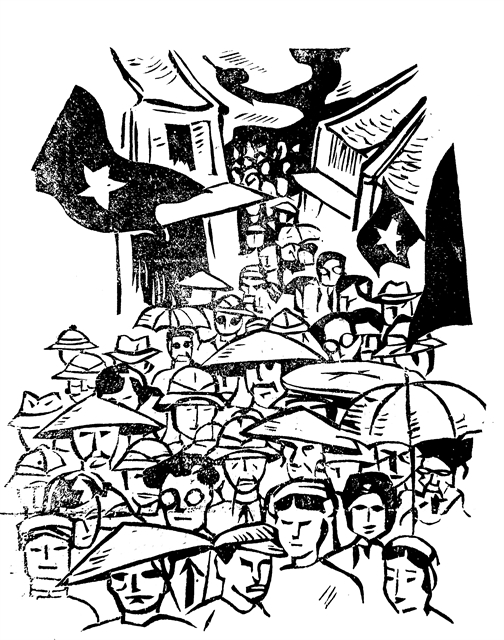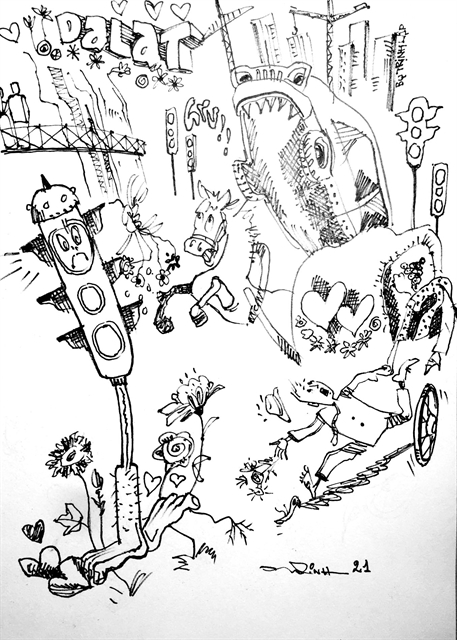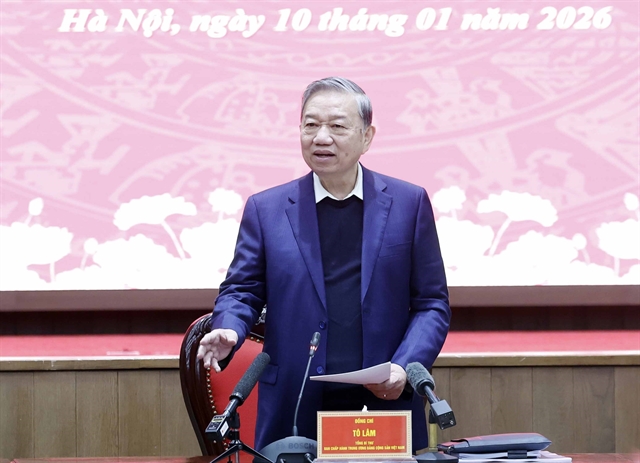 Talk Around Town
Talk Around Town

With its first traffic light installed and six more to come this year, Đà Lạt is no longer the “city without traffic lights, cyclos, and air-conditioners” that it’d long been known as, raising different reactions among those who care about it.

|
| Illustration by Trịnh Lập |
Đinh Vũ Bảo Hoa
My father used to live in Đà Lạt. Last week when I told him the city had installed its first ever traffic light, he said: “That sucks. I’ll never go there again.”
In his mind the Central Highlands resort city was this deserted, peaceful, and somewhat boring mountain place where he came to live for a year when he was 18 years old.
“I walked all over Đà Lạt,” he often told me, stressing that at that time our country was poor, vehicles were scarce, and he literally roamed the city on foot. “I could never imagine a day when Đà Lạt has a traffic jam,” he said.
But nearly 40 years later, that day has come. Due to the large number of tourists flocking to Đà Lạt during weekends and holidays, traffic congestion has become so common in the city that after a decade of debate, its authorities have decided to install traffic lights at major intersections to ensure road safety.
The first one was put up last week at the Hoàng Văn Thụ – Trần Phú – 3 Tháng 2 roundabout. Six more will be put into place, and they will all go into operations by the end of the year.
With that, Đà Lạt is no longer the “city without traffic lights, cyclos, and air-conditioners” that it had long been known as, raising different reactions among those who care about it. Some are amused and excited at the change, but some think the lights signal the loss of the city’s signature slow pace of life and its people’s gentleness, a quality that has helped them navigate the streets without rushing or yelling at each other – and of course, without the help of traffic lights.
I felt half excited, half anxious upon hearing the news. To me the appearance of the traffic lights is a benchmark of development for Đà Lạt, a city I have a personal connection to, and always look forward to visiting.
My father returned to Hà Nội to finish college, but his brother settled down in Đà Lạt and built a family there. In 2004 when I was in fifth grade, my parents took me and my sister to spend three weeks of summer break with my uncle’s family.
Đà Lạt to me then was a misty, foggy, quiet place where it rained all the time, and when we were not at home hiding from the rain – which we did a lot – we were out visiting the waterfalls, the forests, and immersed in the beautiful nature that made up a big part of the city’s identity.
Fifteen years later, in 2019, I returned to Đà Lạt for the first time in search of the peaceful, rather languid way we spent our time that summer, only to realise that city had changed so much I could barely recognise it.
The fresh, cool climate was still there, but the energy was different – more vibrant and touristy. I tried finding my uncle’s house without asking him for the address, and I couldn’t. I remembered it was not far from the downtown area, and the road that led up to it was wide, muddy, and without many houses. But to my surprise that road was now much narrower, and there were so many motorbikes and cars running through it that I had to stop and watch carefully before crossing, which I never thought I would have to do.
There were also many more hostels, homestays, restaurants and coffee shops than before.
Đà Lạt has been growing, and it will not stop in the near future. With spectacular landscapes and a rich history, the city’s tourism potential is immense.
For the local authorities, the tourism, trade and service industry has long been considered the spearhead for Đà Lạt’s economy, making up 67.5 per cent of its economy in 2020 and playing a decisive role in its Gross Regional Domestic Product growth.
In 2019, before the coronavirus pandemic began, the city welcomed more than 6.3 million tourists, of which international visitors accounted for over 14 per cent. Its total revenue from tourism reached VNĐ61.6 trillion (US$2.6 billion) in 2020, and during the 2016-20 period, each year the number of visitors coming to the city increased by 9.5 per cent.
These numbers show that people will keep coming to Đà Lạt, and modernisation is inevitable. More tourists mean a stronger economy, more money spent, and more jobs created for the locals. That’s good for a city whose main sources of income come from agriculture and tourism.
So maybe I should stop making a fuss about changes and traffic lights.
But deep down I wish I could go back to that summer we spent with our extended family, when I was freed from the hustle and bustle of a big city and left to enjoy the serenity and peace of the hill town. This is, no doubt, a sentiment a lot of people share when thinking about Đà Lạt, my father included.
I hope the changes won’t be too drastic, and Đà Lạt will be able to retain the sophisticated traits that have made so many people fall in love with it. I hope its hills, pine forests, twisting roads, lakes, waterfalls, and reminders of French colonial heritage will be preserved, not replaced by cable cars, trade centres or apartment buildings.
And I hope that despite the traffic lights – or any other developments that may come into existence in Đà Lạt in the future – people from previous generations like my father can still find in it the things they love, or the things they fell in love with many years ago. VNS




